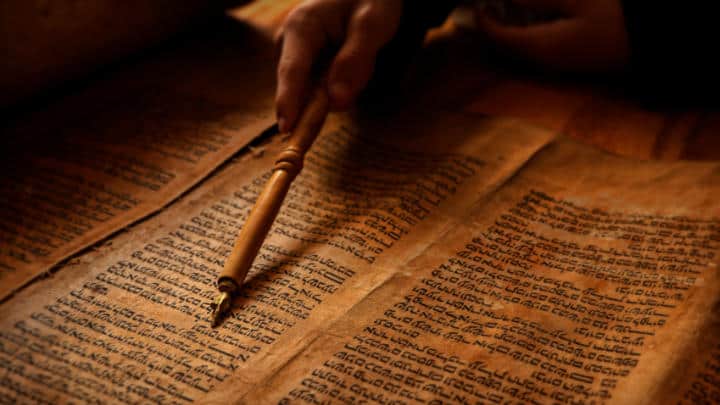
This lesson is the first of three lessons in our series explaining how the Bible is organized. For more help, be sure to review our Bible worksheets on the divisions of the Bible.
- You are here – Lesson: Understanding Bible Layout
- Lesson: Understanding the Old Testament
- Lesson: Understanding the New Testament
TARGET AGES: 10-14
OBJECTIVE: To understand the layout of the bible so we can be better equipped and informed on how to learn about God.
MAIN IDEA: The bible is complete truth. It is organized by sections, books, chapters, and verses which help us better understand the saving message of Jesus Christ.
SCRIPTURE PASSAGES: Psalm 119:105, 2 Timothy 3:16-17, Psalm 119:11
MATERIAL(S): Bible Bingo Cards (download attachment), envelope, scissors, pencils
Introduction (5 minutes)
OPENING PRAYER: Ask for prayer requests and allow volunteers to pray for each request. Finish the prayer by saying, “Lord, we know that your word is truth. Help us today as we seek to understand the bible’s organization and use it to learn more about you. Amen.”
Lesson (15 minutes)
- Start by asking students to briefly flip through their Bibles and announce the divisions they see (Old versus New Testament, books, verses, paragraphs, page numbers, etc). Explain that most of these divisions were added to help us better understand what was written, and the organization helps us to see the big picture of the Gospel. Read Psalm 119:105. Ask, “What divisions are in your school books? They are set up very similarly to the Bible so you are given the best chance of understanding what is written. Psalm 119:105 tells us that God’s word is a ‘lamp’ to our feet and it helps us understand truth.”
- Explain to the students that we are going to learn over the next few weeks how the Bible was put together and why it is organized a certain way. Tell everyone to turn to the table of contents in their Bibles and ask, “How many books are in the Bible (66)? Would anyone like to guess how many authors contributed to the Bible (approximately 40 over 2,000 years)? So how do we know whether or not all those authors wrote the right things?” Allow time for students’ answers. Then turn to 2 Timothy 3:16-17 to show students that everything in the Bible is God-breathed and each author was lead by the Holy Spirit. Say, “Everything in the Bible can be trusted as truth because God continues to speak the same message of salvation and redemption in every book!”
- Ask, “Does anyone know how all the Biblical writings were put together?” Explain that for 2,000 years scribes, priests, and other record keepers passed on biblical writings until 397 A.D. when the final list was put together. The criteria for the books: they had to have obvious Godly authority (e.g. “Thus says the Lord”), the authors either had to have personally known Christ or been a disciple of one of his close followers (e.g. Luke who had gathered information about Jesus and was a companion of Paul), and the books had to contain important information that pointed to Jesus and salvation (God’s ultimate plan for mankind). Say, “While the books we have in our Bibles are not the only books ever written about God (e.g. the Catholic Apocrypha with additional writings), we can trust that the books we do have all point to Christ and God’s ultimate plan for redemption of mankind. Anything else is extra information and could lead to confusion, so God has preserved these 66 books as His own personal witness of truth.”
- Read Psalm 119:11 and encourage students to memorize scripture to remember biblical truths. Tell students that next week we will learn specifically about how the Old Testament is set up and how it helps us mature in our relationships to Christ.
Conclusion (5 minutes)
RECAP: The bible’s organization helps us understand the message of Christ.
CLOSING PRAYER: “God, thank you for the bible and for your truth. Remind us to practice studying and reading our bibles to discover more about you. Amen.”
Bible Book Bingo (20 minutes) *Download Attachment*
Use the remaining class time to play Bible Book Bingo. Cut out the bingo cards and selection cards. Pass out the bingo cards and place the selection cards in an envelope. Draw one selection card at a time and call out the chosen bible book. Tell the students to “X” the bible book if they have it on their cards. The first student to “X” five boxes in a row wins! Consider bringing several small prizes. TIP: Print two or three copies of each card to play multiple rounds.

This whole lesson series and worksheets are fabulous and just what I was looking for. Everything is complete and clearly mapped out. Thank you!
How do I download everything at once? I got lost after downloading a few OT study guides.
Thanks for asking. We don’t have this series combined into one yet since there are only three lessons, that’s something we can add to our list.
How to teach books of the Bible to 4-10 year olds?
Thanks